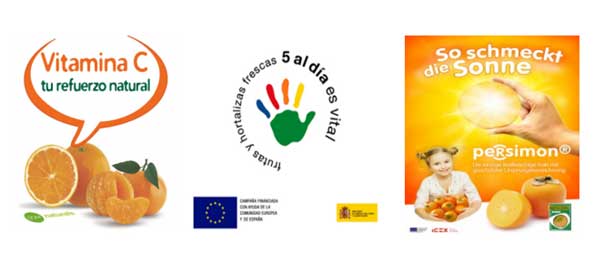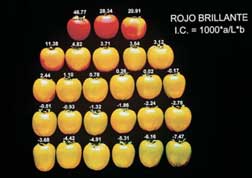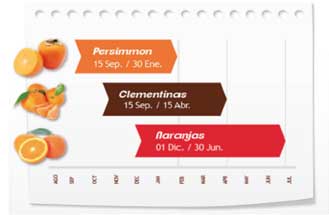Solution
1. What improvements need to be made to cope with the new production and the current annual production of oranges and clementines?
To the best of our knowledge, this question is difficult to answer because it is too general. To produce a new fruit in the company, a new number of trees must be planted (so that also the place to plant them must be available), to be collected by workers… 2 variables need to be considered.
- Whether the company has room for the storing rooms persimmon need (chambers with a temperature of 20º, an atmosphere controlled with 5,000 ppm of ethanol and a relative humidity of 90%)
- Important to check growing times and numbers of (Sharon type) persimmon per tree and year
- At least, the contract of the collectors and processors is the same as the collection of persimmon is in coincidence (partly, up to the en d of January) with the collection period of the clementines for which the company needs to see how many workers will need to hire to also cope with the collection and process of persimmon (from 15 september to 30 January).
All this takes time, so immediate introduction of the product is not possible.
2. What permits are required to obtain from the authorities to start this new production? Does persimmon comply with all health, consumer protection, and regulations?
At this point I will name the most important regulations that influence the fruit and vegetable sector, in this case as I have indicated in points above the destination market fruit is not only Spanish but also outside our borders. By belonging to the European Union, we also must consider the laws at the community level that exist. For this sector, these standards are included in Regulation (CE) nº 1234/2007, of the Council and in Implementing Regulation (EU) No. 543/2011, of the Commission and includes the regulation of exchanges and support to the product fresh sector to improve your competitiveness. This regulation indicates the marketing standards applicable in all phases of marketing including export and import that all companies must follow. Establishes the minimum requirements for quality, maturity, tolerances and marking of origin of the product. Depending on the type of vegetable or fruit, it must comply with rules such as definition of the product, its classification into categories, calibration, commercial characteristics, as well as a non-exhaustive list of varieties for some of them. These standards correspond to the international standards of the UNECE (Commission Economic for Europe of the United Nations Organization.). Moreover, the EU CAP Common Agricultural Policy. The company has all these in place to cope with the production of oranges and clementines.
3. Are new packages needed for persimmon?
The company has oranges and clementines packages: cardboard, wood and plastic for a weight that goes from 3 to 25 Kg also using meshes (for weights 3 to 5 Kg). For persimmon, it is advised to use similar packages (cardboard, wood, and plastic) but keep them to a weight from 3 to 10 Kg. It is also important to make sure that in the packaging of persimmons we do not use the meshes we use for oranges and clementines. Persimmon does not have the crust as hard as oranges and a mesh could produce friction in the persimmon rind while in transit. Due to this, it should be noted that in this step a control of the quality of samples is crucial to make sure the quality of persimmon is checked to assure it is optimal for consumption.
4. What promotional strategy should be used to launch the new product on the market and at what cost?
In the case of citrus and fruit and vegetable companies in general, it was not until the end of the 90s when marketing was given importance, until then promotions and marketing was based exclusively on participation in fairs (local, national, EU and international). Marketing strategies need to be implemented gradually. They already have a brand for oranges (called naranjita) and clementines (mandarina) so a new brand is to be introduced. Now, it is important to point out that not only traditional advertising is important (television, radio, or press, etc.), today there is a much more important publicity: social networks, a website with company information and a blog ad test the possibility of direct delivery to consumers. This strategy makes the fruit company closer to their consumers knowing their opinion and likes about their product, particularly if the want to introduce a new product. The company can run campaigns and promotions that can be based on their normal production of oranges and clementines to also introduce persimmon.
5. What should the new advertisement look like?
Analysisng some current campaigns, it is important to fucus on images of the product:

Moreover, it is important to make emphasis on the key features of Persimmon: as an example:
The yellow-orange persimmon fruit is an excellent source of fiber, Vitamin A (it contains carotene and cryptoxanthin, both with provitamin A activity, very interesting nutritionally) and a high level of vitamin C, vitamin B6, potassium and the mineral manganese. Persimmons are fat-free and are a good source of healthy carbohydrates and natural sugar. They have an antioxidant activity with beneficial effects, as they decrease the risk of certain degenerative diseases (cancer, cardiovascular, diabetes, cancer, and neurological conditions like Alzheimer’s etc.).
6. What should the new product look like?
According to the Agrarian Institute of Fruits (2015) from the autonomous community of Valencia, the average weight of a persimmon persimmon is 400 grams and a diameter of 9 ms ranging with the different types of measures and colours. It is advised that the boxes have the pieces of fruit as similar as possible between the (both colour and size).

Presentation




Review M1S2 – DUCK Persimmon Fruit.
You must be logged in to post a review.